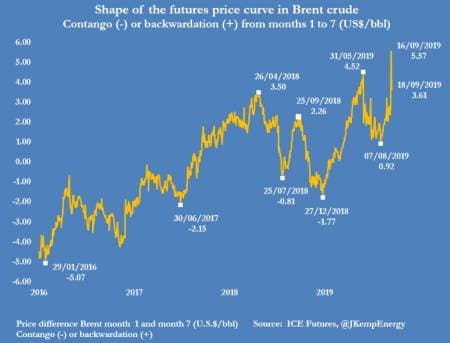Friday September 20, 2019
1. Abqaiq attack and restoration scenarios
- The oil market saw the largest supply disruption in its history last Saturday, with 5.7 mb/d of supply going offline.
- Saudi Arabia says that it has restored 2 mb/d of capacity, and that production would reach pre-attack levels by the end of the month. Still, damaged capacity would take until the end of November to restore. Oil prices plunged on the news, as markets were surprised by the aggressive and optimistic restart schedule.
- Some analysts view it as overly optimistic. “Don’t get too excited. There is clear risk of a slower restart of Saudi Arabian oil production despite the optimistic guidance by Saudi Aramco,” Bjørnar Tonhaugen of Rystad Energy said. The consultancy says that 1.6 mb/d of Arab Light and 0.35 mb/d of Arab Extra Light would remain shut in through October.
- In Rystad’s “slow restart” scenario, the facility would only have 45 percent of capacity operational by the end of September (versus 40 percent currently) and 65 percent by the end of October.
- On the other hand, a “quick restart” case would see 65 percent operational by end-September and 100 percent by the end of October.
2. Abqaiq attack highlights supply risk
- Even if Saudi Arabia succeeds in a quick restart of the Abqaiq facility, the attack shattered the perception of security surrounding Saudi Arabia’s massive oil fields and processing installations.
-…
Friday September 20, 2019
1. Abqaiq attack and restoration scenarios

- The oil market saw the largest supply disruption in its history last Saturday, with 5.7 mb/d of supply going offline.
- Saudi Arabia says that it has restored 2 mb/d of capacity, and that production would reach pre-attack levels by the end of the month. Still, damaged capacity would take until the end of November to restore. Oil prices plunged on the news, as markets were surprised by the aggressive and optimistic restart schedule.
- Some analysts view it as overly optimistic. “Don’t get too excited. There is clear risk of a slower restart of Saudi Arabian oil production despite the optimistic guidance by Saudi Aramco,” Bjørnar Tonhaugen of Rystad Energy said. The consultancy says that 1.6 mb/d of Arab Light and 0.35 mb/d of Arab Extra Light would remain shut in through October.
- In Rystad’s “slow restart” scenario, the facility would only have 45 percent of capacity operational by the end of September (versus 40 percent currently) and 65 percent by the end of October.
- On the other hand, a “quick restart” case would see 65 percent operational by end-September and 100 percent by the end of October.
2. Abqaiq attack highlights supply risk

- Even if Saudi Arabia succeeds in a quick restart of the Abqaiq facility, the attack shattered the perception of security surrounding Saudi Arabia’s massive oil fields and processing installations.
- It also highlights the fragility of the global energy system, and thus, the dependence of the global economy on a handful of critical pieces of infrastructure concentrated in relatively few areas. “There are so many critical assets, but they’re not all defended assets,” Thomas Karako, director of the Missile Defense Project at the Center for Strategic and International Studies, told the Wall Street Journal.
- Oil markets have shrugged off years of attempted attacks on Saudi oil assets. In some months, Saudi Arabia would see more than a dozen attempted attacks from the Houthis. Only this year did the attacks attract major headlines, particularly surrounding some drone strikes on pipelines and the explosions of tankers in the Persian Gulf.
- “The big takeaway is that Saudi critical infrastructure—and you can generalize this to any of the Gulf states—is vulnerable,” Seth Jones, a former top official in the U.S. Defense Department’s Special Operations Command, said.
3. Front-end of oil futures curve spikes

- The Abqaiq attack led to a spike of oil prices at the front end of the curve, leading to a sharp backwardation.
- On September 16, as Reuters notes, front-month Brent contracts traded at a $5.50 premium to Brent contracts seven months out. That was the highest six-month premium in seven years.
- The spread reflects significant concerns about near-term supply (i.e. near-term oil contracts are pricey) but less of a concern over supplies several months from now.
- Also, the oil market is expected to be facing a glut in 2020, so the backend of the curve remains lower.
4. U.S. rig count depression, but drilling activity holds up

- The U.S. rig count continues to decline, down 16 percent since late last year. Oklahoma in particular has been hit hard, with rig counts down by 50 percent.
The Permian has held up, and in particular the Delaware section in New Mexico has demonstrated strong interest. In fact, the rig count in the Delaware of New Mexico is near all-time highs.
- Meanwhile, spudded and completed wells in U.S. shale remain elevated, driven by the Permian.
- The lateral length and the use of proppant also continue to rise. “Hence, the demand side of the equation still looks quite favorable for operators and service providers in US land,” Rystad Energy said.
5. Texas dominates wind

- While the Permian basin is the reason behind the so-called U.S. “energy dominance,” Texas also dominates in wind power.
- By 2020, Texas could generate more of its electricity from wind than it does from coal, a highly-anticipated milestone and a dramatic fall for King Coal.
- “Our forecasts suggest that onshore wind in Texas will generate about 87 terawatt-hours (TWh) of electricity by 2020, versus the anticipated 84.4 TWh from coal,” Carlos Torres-Diaz, head of gas market research at Rystad Energy, said in a report. “Texas is just one of many red states that have recently 'gone green' by harnessing their great wind generation potential.”
- Wind is becoming so cheap that it is edging out coal in many states. The global average levelized cost of electricity for onshore wind farms fell below $0.06 per kilowatt-hour in 2018, which only the cheapest fossil fuel plants can compete with.
6. Carbon prices sink after long rally

- European carbon prices rallied this year, after the EU scrapped surplus credits and tightened up the market.
- However, some headwinds have interrupted the rally. The teetering European economy, a contraction in Germany and the rising odds of a no-deal Brexit are sapping industrial demand.
- This week, carbon prices took a nosedive on positive nuclear power news in France. “The carbon price in EU emissions trading fell to around €25 per ton yesterday after the French energy company EDF said it would not for the moment need to close down parts of its nuclear generating capacity (which is responsible for 75% of French electricity production) to carry out maintenance,” Commerzbank wrote in a note.
- Weak natural gas prices are also undercutting carbon prices, by making gas more competitive than coal.
- “However, we anticipate further (political) uplift in the medium term. At the end of the day, national plans – even if not directly linked to EU emissions trading – create sentiment and price expectations,” Commerzbank added, referring to aggressive decarbonization plans from national governments in Europe.
7. Residential solar falls below $3/watt

- The average cost of residential solar fell below $3/watt for the first time ever this year, according to Bloomberg and EnergySage Inc.
- The company says that the average quote for new residential systems stood at $2.99 per watt in the first half of 2019, which is 23 percent lower than five years ago.
- The U.S. installed 2.1 GW of new solar in the second quarter, taking cumulative installations up to 69.1 GW, enough to power 13.1 million homes.
- Total installed PV solar is expected to double over the next five years, with annual growth average 15 GW.
























